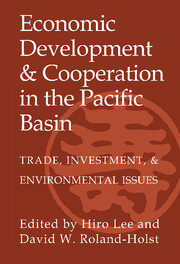 Economic Development and Cooperation in the Pacific Basin
Economic Development and Cooperation in the Pacific Basin Book contents
- Frontmatter
- Contents
- Acknowledgments
- List of Contributors
- I Introduction and Overview
- II U.S.-Japan and Asian Trade Patterns
- 2 Cooperative Approaches to Shifting Comparative Advantage: The Case of Bilateral Trade between the United States and Japan
- 3 Is There an Asian Export Model?
- III Regional Trading Arrangements in the Pacific Basin
- IV Foreign Direct Investment: Determinants and Consequences
- V Trade, Resources, and the Environment
- Index
3 - Is There an Asian Export Model?
Published online by Cambridge University Press: 19 May 2010
- Frontmatter
- Contents
- Acknowledgments
- List of Contributors
- I Introduction and Overview
- II U.S.-Japan and Asian Trade Patterns
- 2 Cooperative Approaches to Shifting Comparative Advantage: The Case of Bilateral Trade between the United States and Japan
- 3 Is There an Asian Export Model?
- III Regional Trading Arrangements in the Pacific Basin
- IV Foreign Direct Investment: Determinants and Consequences
- V Trade, Resources, and the Environment
- Index
Summary
INTRODUCTION
Over the past quarter century, the high-performing Asian economies (Japan, Hong Kong, Singapore, Taiwan, Korea, Malaysia, Thailand, and Indonesia) have nearly tripled their shares of world trade and income. Many observers have identified openness or positive trade orientation as a primary explanation for this enviable performance, though controversy remains as to the nature of the causality between trade and growth.
There is a large and venerable literature that attempts to use cross-national data to model the relationship between trade and growth. These studies typically find a positive relationship between some measure of trade openness or export orientation and income growth, which is interpreted in a causal manner. For example, Levine and Renelt (1992) nested a variety of trade orientation variables in a general model and subjected the estimated regressions to sensitivity tests. They found that there was a positive and robust correlation between investment share and income growth, and between investment and trade shares. They interpreted this as indicating that trade (not exports per se) affects growth through investment, not through improved resource allocation or spillover externalities as previous studies have posited. They did not obtain any robust relationships between a variety of trade policy indicators and growth.
A concern with these studies is possible simultaneity bias problems arising between national income (or growth) on the left-hand side of the regression and its components (exports, investment, or their growth rates) on the right-hand side. Frankel, Romer, and Cyrus (1995) attempt to address this issue by constructing instruments for trade based on the fitted values of a “gravity equation.”
- Type
- Chapter
- Information
- Economic Development and Cooperation in the Pacific BasinTrade, Investment, and Environmental Issues, pp. 78 - 116Publisher: Cambridge University PressPrint publication year: 1998


